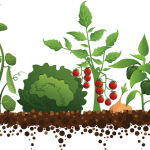 :: environmental impact of fruits/ vegetables :: environmental impact of fruits/ vegetables
(Compared to beef, chicken/ fish/ eggs and dairy products.) Estimated carbon footprint, loss of natural habitat potential for one year, loss of plant and animal life potential for one year, and extinction potential, from making, packaging, shipping and/or using these products or services. |
|||||
| Fruits/ Vegetables – 1 kilogram (2.2 pounds)
CO2 from Richard Heede xoearth.net/ xoe/ p/ DailyCarbonCalcsDec08.pdf. [[#ref1]] 6%-11% is CO2 from shipping to retailer. |
Some of the materials used to grow 1 kilogram (2.2 pounds) of fruits/ vegetables.
water, pesticides, fertilizer, gasoline, diesel fuel. |
CO2 released to grow 1 kilogram (2.2 pound) of fruits/ vegetables.
1.59 kg |
Loss of natural habitat potential to grow 1 kilograms (2.2 pound) of fruits/ vegetables.
1.2 m^2 |
Loss of plant and animal life potential (in natural habitat) to grow 1 kilograms (2.2 pound) of fruits/ vegetables.
3.8 kg |
How many kilograms of fruits/ vegetables it takes to trigger 1 potential species extinction.
123 million |
| Beef – 1 kilogram (2.2 pounds)
CO2 from Richard Heede xoearth.net/ xoe/ p/ DailyCarbonCalcsDec08.pdf. [[#ref1]] 1% of the CO2 from shipping to retailer. |
Some of the materials used to raise 1 kilogram (2.2 pounds) of beef.
fertilizer, grain, pesticides, antibiotics, gasoline |
CO2 released to raise 1 kilogram (2.2 pound) of beef.
22.1 kg |
Loss of natural habitat potential to raise 1 kilogram (2.2 pound) of beef.
17 m^2 |
Loss of plant and animal life potential (in natural habitat) to raise 1 kilogram (2.2 pound) of beef.
53 kg |
How many kilogram of beef it takes to trigger 1 potential species extinction.
8.8 million |
| Chicken/ Fish/ Eggs – 1 kilogram (2.2 pounds)
CO2 from Richard Heede xoearth.net/ xoe/ p/ DailyCarbonCalcsDec08.pdf. [[#ref1]] 3%-7% is CO2 from shipping to retailer. |
Some of the materials used to raise 1 kilogram (2.2 pounds) of chicken/ fish/ eggs.
fertilizer, grain, pesticides, gasoline, diesel fuel. |
CO2 released to raise 1 kilogram (2.2 pound) of chicken/ fish/ eggs.
5.96 kg |
Loss of natural habitat potential to raise 1 kilograms (2.2 pound) of chicken/ fish/ eggs.
4.6 m^2 |
Loss of plant and animal life potential (in natural habitat) to raise 1 kilograms (2.2 pound) of chicken/ fish/ eggs.
14.3 kg |
How many kilograms of chicken/ fish/ eggs it takes to trigger 1 potential species extinction.
32.7 million |
| Dairy products – 1 kilogram (2.2 pounds)
CO2 from Richard Heede xoearth.net/ xoe/ p/ DailyCarbonCalcsDec08.pdf. [[#ref1]] 3%-7% is CO2 from shipping to retailer. |
Some of the materials used to make 1 kilogram (2.2 pounds) of dairy.
fertilizer, grain, water, pesticides, antibiotics, gasoline, diesel fuel. |
CO2 released to make 1 kilogram (2.2 pound) of dairy products.
4.13 kg |
Loss of natural habitat potential to make 1 kilograms (2.2 pound) of dairy products.
3.2 m^2 |
Loss of plant and animal life potential (in natural habitat) to make 1 kilograms (2.2 pound) of dairy products.
9.9 kg |
How many kilograms of dairy products it takes to trigger 1 potential species extinction.
47 million |
==Summary==
The production of 1 kilogram (2.2 pounds) of dairy products results in about 4 kilograms (9 pounds) of CO2 emissions – including production of grains and feed, materials, production and shipping.[[#ref1]]
The loss of natural habitat potential from 1 kilogram (2.2 pounds) of dairy products is estimated to be 3.2 square meters (34 square feet).
==Notes==
“… a totally “localized” diet reduces GHG [green house gas] emissions per household equivalent to 1000 miles/yr (1600 km/yr) driven, while shifting just one day per week’s calories from red meat and dairy to chicken/fish/eggs or a vegetable-based diet reduces GHG emissions equivalent to 760 miles/yr (1230 km/yr) or 1160 miles/yr (1860 km/yr), respectively. Shifting totally away from red meat and dairy toward chicken/fish/eggs or a vegetable-based diet reduces GHG emissions equivalent to 5340 mi/yr (8590 km/yr) or 8100 mi/yr (13000 km/yr), respectively. [[#ref1]]
==References==
1. Richard Heede xoearth.net/xoe/p/DailyCarbonCalcsDec08.pdf
2. American Chemical Society pubs.acs.org/doi/full/10.1021/es702969f
3. Scientific American www.scientificamerican.com/article/the-greenhouse-hamburger/ February, 2009 14.8 pounds of CO2 pound for pound [of beef]
4. Anderson, Kathryn (2007) Food, a paper for “Toward an Ethical CO2 Emissions Trajectory for Princeton”, p. 14: conventional beef averages 13.04 lb CO2e per lb ground beef.
==External links==
en.wikipedia.org/wiki/Fruit
[[category:Food]] [[category:Products]]

Leave a Reply
You must be logged in to post a comment.